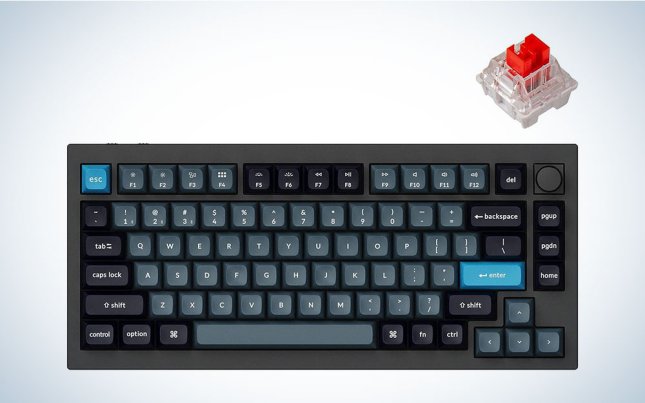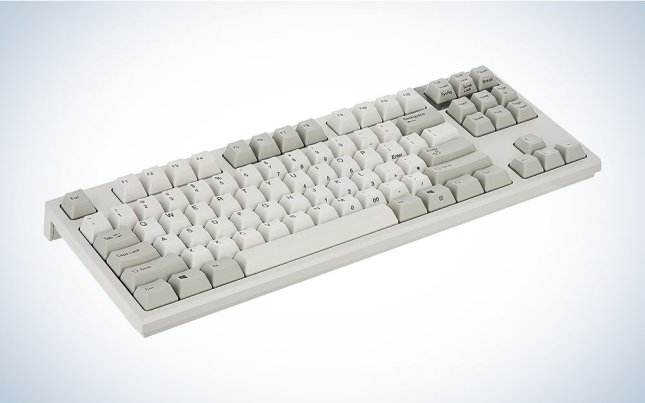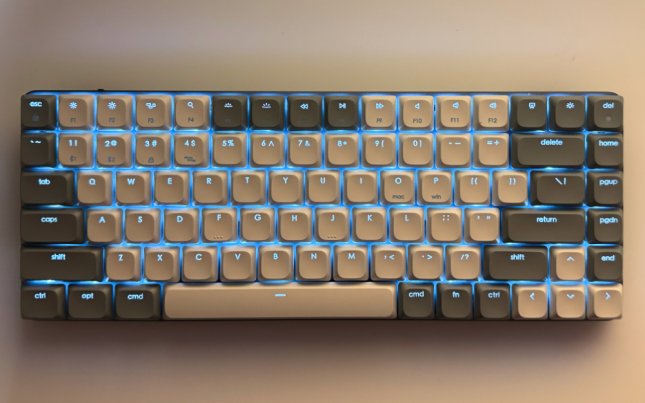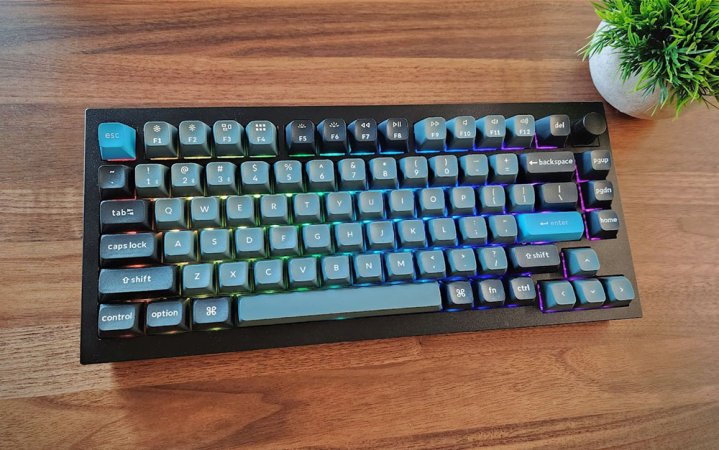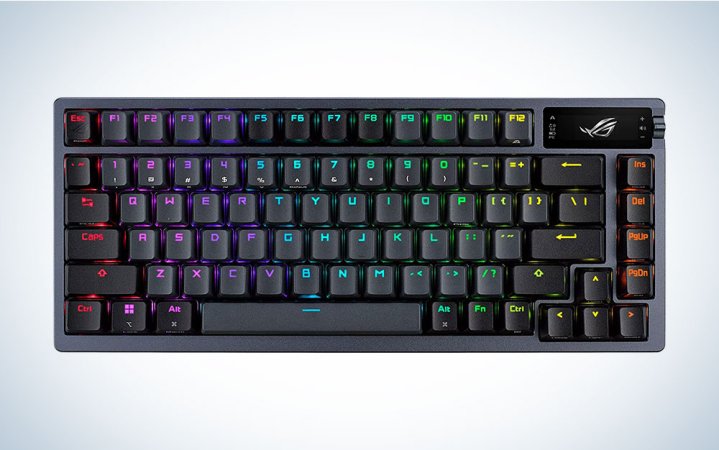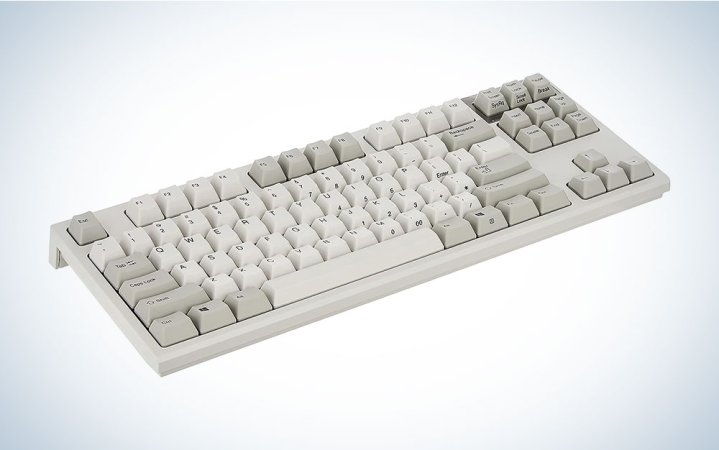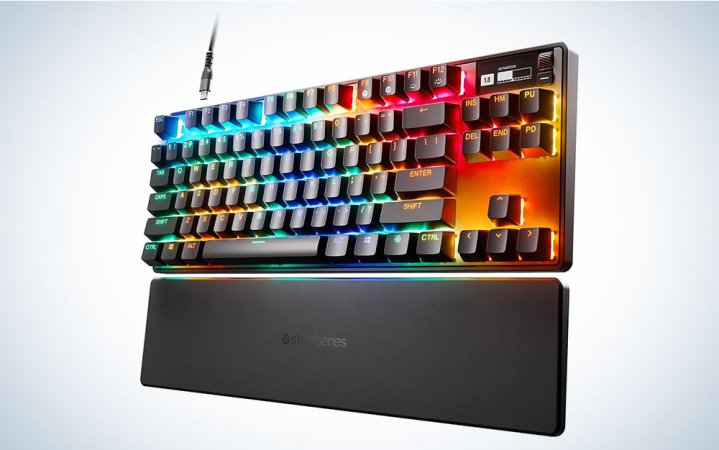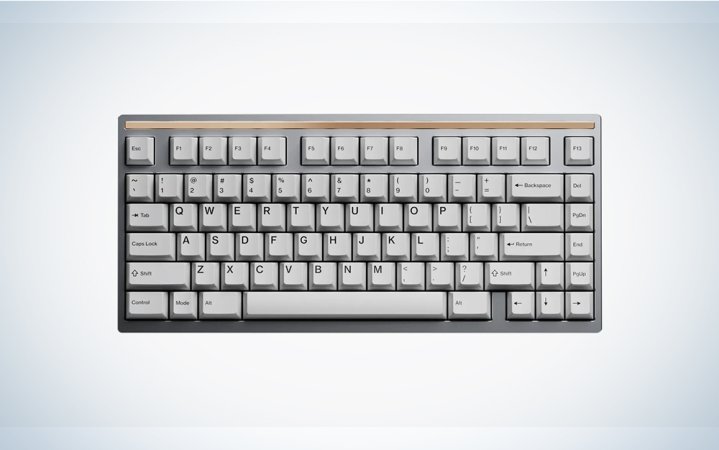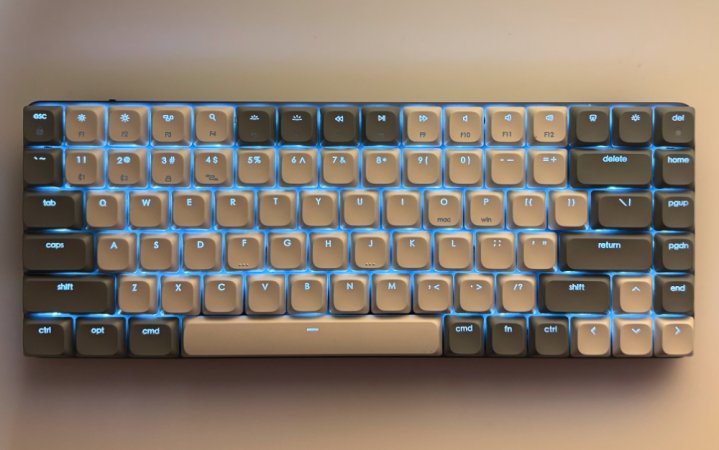We may earn revenue from the products available on this page and participate in affiliate programs. Learn more ›

Investing in mechanical keyboards is one of the best ways to improve your computer experience. Whether you’re looking for something to help you work more efficiently or to gain the edge on your opponents while gaming, this type of keyboard is responsive, reliable, and feels great to use. If you’re contemplating upgrading to a mechanical keyboard, there’s much to consider, but we’re here to help. We’ve gathered all the important info, from the things to look for when shopping to the brass tacks of what’s best to buy right now. Don’t go in blind. If you’re just looking for the TL;DR, these are the best mechanical keyboards of 2024 so far.
- Best overall: Keychron Q1 Pro
- Best wireless: Corsair K100 Air
- Best for gaming: ASUS ROG Azoth
- Best for Mac: Logitech MX Mechanical Mini for Mac
- Best for typing: Fujitsu Realforce R2 TKL
- Best TKL: Steelseries Apex Pro TKL
- Best custom: Mode Sonnet
- Best budget: Satechi SM1
How we chose the best mechanical keyboards
I’ve been writing online since 2008 and officially joined the games press in 2013. In 2015, I moved to covering tech full-time and have written about hundreds of keyboards since for outlets like IGN, Tom’s Hardware, Reviewed, Popular Mechanics, and, of course, Popular Science. During that time, I’ve come to regard the keyboard as a tool and the gateway to my craft. I’ve also grown to appreciate just what makes a keyboard great—and it’s not just the presence of mechanical keys. It’s the sound, feel, and responsiveness. The best mechanical keyboards provide a satisfying experience that makes you want to return and continue typing.
For this round-up, I began by considering the masses of keyboards I’ve covered and the wave-makers I missed out on. I culled a list of more than 25 keyboards down to the top seven, using a mix of my own experiences with five of my top picks and deep research into the remaining two, balancing professional reviews with first-hand user impressions. I considered more than just switches. Small touches, like how smooth the keys are, the quality of the keycaps and case, connectivity and media control options, and whether the manufacturer made any special considerations for elements like sound-dampening foam. Our final picks represent a wide array of potential options, but each is sure to impress for its particular category.
The best mechanical keyboards: Reviews & Recommendations
With all those considerations in mind, you’re equipped to make the best choice for your typing needs. If you’d rather save yourself time, we’ve researched for you. If you’re looking for the key(s) to better typing and gaming, the best mechanical keyboard can unlock that and more.
Best overall: Keychron Q1 Pro
Best overall
Keychron Q1 Pro
Why it made the cut: The Keychron Q1 Pro is one of the most solidly built, best feeling, best sounding mechanical keyboards you can buy. It’s not cheap but is still a great value.
Specs
- Price: $219.99
- Size: 12.89 x 5.71 x 1.41 inches
- Layout: Compact TKL
- Switches: Linear, clicky, tactile
- Keycaps: Doubleshot PBT (non-backlit)
- Backlight: Yes, programmable RGB
- Connectivity: Bluetooth, wired
- Battery Life: Up to 300 hours
- Software: QMK/VIA
Pros
- Heavy aluminum case that feels exceptionally premium
- Excellent, smooth switches and durable, colorful keycaps
- Highly programmable for Mac or Windows
Cons
- Tall keycaps have a learning curve
- Isn’t easy to travel with
The Keychron Q1 Pro is the follow-up to the original Keychron Q1, our prior pick for the best overall keyboard. With the new Pro model, the Q1 is better than ever. It carries through everything we loved about the original, including its heavy-duty and exceptionally premium-feeling aluminum case, and adds Bluetooth wireless connectivity. Even though aluminum cases tend to block wireless signals, the Q1 offers a reliable and fast Bluetooth connection, allowing you to cut the cord without cutting quality. Just don’t plan on traveling with it: This keyboard is hefty at just under four pounds.
Bluetooth isn’t the only improvement that comes with the Q1 Pro. Its internals have also been reworked, delivering the softest typing experience yet and satisfyingly supple acoustics. The switches are pre-lubed for extra smoothness, and a brand new set of doubleshot PBT keycaps add a splash of color and heightened durability. The only downside is that they’re a touch taller than average keycaps and take an hour or so to adapt to. The Q1 Pro isn’t cheap, but it still manages to feel like a steal once you’ve put your fingers to it.
Best wireless: Corsair K100 Air Wireless
Best wireless
Corsair K100 Air Wireless
Why it made the cut: The Corsair K100 Air Wireless offers excellent responsiveness in a shockingly thin package. It’s perfect for the desk but can just as easily be used on your lap with a console.
Specs
- Price: $279.99
- Size: 17.3 x 6.15 x 0.67 inches
- Layout: Full-size
- Switches: Tactile, ultra-low profile
- Keycaps: Doubleshot
- Backlight: Yes, programmable RGB
- Connectivity: Bluetooth, 2.4GHz, wired
- Battery Life: Up to 200 hours
- Software: Corsair iCUE
Pros
- Excellent tactile switches
- Versatile design lends itself to multiple uses
- Ultra-low profile
Cons
- Full-size only
- Easily damaged by tinkerers
There are lots of wireless mechanical keyboards, but there’s nothing out there quite like the Corsair K100 Air Wireless. That’s because this keyboard uses Cherry’s MX Ultra Low Profile tactile switches, allowing it to be fully mechanical yet only 11mm at its slimmest point. Thinness doesn’t equate to great wireless, but it does make the K100 Air uniquely versatile. You can use it on a desk and enjoy wired-like performance over its fast 2.4GHz SlipStream Wireless connection or use it on your lap with a home theater PC or game console over Bluetooth. Its slimness and excellent wireless connectivity lend themselves to movement in a way few other keyboards do.
The K100 Air features up to 200 hours of battery life with RGB off and up to 50 hours with backlighting enabled. You may just want to leave it on, too, because the RGB is bright, vibrant, and highly programmable using Corsair’s iCUE software. It’s not a keyboard to be tinkered with, however, as its low-profile switches are quite fragile, but given its design, there’s not much to customize anywhere. The biggest thing we wish is that smaller versions were available that were easier to carry in a bag!
Best for gaming: ASUS ROG Azoth
Best for gaming
ASUS ROG Azoth
Why it made the cut: The ASUS ROG Azoth blends enthusiast keys with dedicated gaming features, a mouse-friendly design, and shockingly great battery life. It’s bound to impress.
Specs
- Price: $199
- Size: 12.83 x 5.35 x 1.57 inches
- Layout: Compact TKL
- Switches: Linear, clicky, tactile
- Keycaps: Doubleshot PBT (backlit)
- Backlight: Yes, programmable RGB
- Connectivity: Bluetooth, 2.4GHz, wired
- Battery Life: Up to 2,000 hours
- Software: ASUS Armoury Crate
Pros
- Fast, reliable wireless connectivity (Bluetooth and 2.4GHz)
- Extra smooth, extra durable switches and keycaps
- Maximum battery life is ridiculously high
Cons
- Battery life is much less with RGB enabled
- ASUS Armoury Crate feels unpolished
The ASUS ROG Azoth is the apex of gaming keyboard design. It features an OLED screen for easy lighting and connectivity controls and a volume level for dedicated media controls. Its compact design leaves plenty of room for your mouse hand while ensuring you have a full function row and arrow keys for all your in-game abilities. It’s also completely remappable using ASUS’s Armoury Crate software, so you can reassign keys and macros and even create custom layouts for individual games (though the software still feels a bit rough around the edges).
What really sets it apart, though, is how amazing it feels to use. The Azoth is built to a high standard inspired by the expensive custom mechanical keyboards that often cost hundreds of dollars. That means super smooth, pre-lubed switches perfect for rapid-firing abilities in games and backlit PBT keycaps that show your legends in the dark but will still look like new years into the future. In addition, layers of silicone and sound-dampening foam deliver a soft, quiet, and ASMR-like typing experience. This is a quiet mechanical keyboard that will make you want to come back for another round just to use it for a little bit longer.
The Azoth can also be used completely wirelessly over Bluetooth or ASUS’s SpeedNova 2.4GHz wireless. What’s even more impressive is that it’s rated for up to 2,000 hours of battery life with RGB disabled. Turning the RGB on dramatically reduces this, and though ASUS doesn’t provide any expected uptime, we estimate needing to recharge once every couple of weeks, depending on how often it’s used.
Best for Mac: Logitech Mechanical Mini for Mac
Best for Mac
Logitech MX Mechanical Mini for Mac
Why it made the cut: The Logitech MX Mechanical Mini for Mac might be a mouthful, but it offers an excellent, Mac-friendly typing experience with a productivity-enhancing feature set.
Specs
- Price: $129.99
- Size: 13.4 x 6.1 x 2.4 inches
- Layout: Compact TKL
- Switches: Tactile Quiet
- Keycaps: ABS (backlit)
- Backlight: Yes, programmable white
- Connectivity: Bluetooth, wired
- Battery Life: Up to 10 months
- Software: Logitech Options+
Pros
- Instant Mac compatibility
- Excellent software support
- Low profile yet mechanical keys
Cons
- Keycaps aren’t durable
- Only one switch option
Look, there’s no shortage of mechanical keyboards that say they support Mac, but if you’re looking for something that’s fully integrated with macOS, it doesn’t get better than the Logitech MX Mechanical Mini for Mac. This keyboard features a low profile design that’s easier to adapt to for fans of Apple’s official Magic Keyboard and uses tactile, quiet switches for easy use at home or the office. It features a function row replete with helpful shortcuts, including the ability to switch between three Apple devices on the fly. It even comes in a Pale Grey color with a white backlight for a clean, minimalist aesthetic that goes great with any Mac (and extends to a corresponding mouse, as well).
The appeal of the Mechanical Mini only grows when you factor in Logitech’s Options+ software. This suite allows you to reprogram the function row to improve your workflow and even provides access to Smart Actions. This series of tools can automate repetitive tasks like launching all the applications and websites you need to start your workday. If you’re using multiple systems, you can install Options+ on both to be able to seamlessly swap between them with the push of a button.
The MX Mechanical Mini is fantastic, but it has limitations. The keycaps are made out of ABS plastic, which means they’ll show signs of wear sooner rather than later. There’s also only one switch option to choose from, unlike the PC version of the keyboard. Still, these are small shortcomings on an otherwise excellent mechanical keyboard.
Best for typing: Fujitsu Realforce R2 TKL
Best for typing
Fujitsu Realforce R2 TKL
Why it made the cut: The Fujitsu Realforce R2 TKL puts typing center-stage. What it lacks in programmability, it makes up for in how great it is to type on.
Specs
- Price: $258
- Size: 14.5 x 5.6 x 1.2 inches
- Layout: TKL
- Switches: Electrocapacitive
- Keycaps: Doubleshot PBT
- Software: None
Pros
- Soft electrocapacitive switches
- Switch weight varies to cater to each finger
- Ergonomic sculpt to the (great) keys
Cons
- Expensive
- Not programmable
- Retro aesthetic
The Fujitsu Realforce R2 TKL is perhaps the most unique keyboard in our round-up. It is not, in fact, mechanical—at least in the truest sense of the word. Instead, this keyboard uses Topre electrocapacitive key switches. These switches are coveted in the mechanical keyboard community due to their pillowy softness and uniquely gentle sound profile. For pure typing, the Realforce R2 is as close as you can get to typing on a cloud.
The way these switches work is part of what makes them great and why this particular model made its way onto our list. Underneath each keycap is a high-quality rubber dome, positioned on top of a spring. The dome is what makes typing feel so soft, while the spring provides the kind of crisp, responsive feedback typical of the best ergonomic mechanical keyboards. This model even features mixed sensitivities based on your individual fingers. The keys closer to the center are heavier, matching your stronger index, middle finger, and thumb. The farther keys, pressed by your ring and pinky fingers, are more sensitive to cater to your weaker fingers.
The biggest downside to the Realforce R2 is that it’s literally all about typing. There’s no supporting software, no programmability, and there’s no RGB. It also has a uniquely retro beige aesthetic that seems pulled straight from the last century. The good news is that there are multiple versions available, including those with RGB and even adjustable actuation points, so you can set your own sensitivity.
Best TKL: Steelseries Apex Pro TKL
Best TKL
Steelseries Apex Pro TKL
Why it made the cut: The Steelseries Apex Pro TKL offers more options than most other TKLs could dream of. With custom magnetic switches and an OLED screen, it’s great for both gaming and productivity alike.
Specs
- Price: $139.99
- Size: 5.04 x 14 x 1.65 inches
- Layout: TKL
- Switches: Linear (Omnipoint Magnetic)
- Keycaps: PBT (backlit)
- Backlight: Yes, programmable RGB
- Software: Steelseries GG
Pros
- Smooth magnetic switches
- Adjustable actuation (sensitivity) for customized typing
- Highly programmable
Cons
- Software can be intimidating
The Steelseries Apex Pro TKL is the successor to the original Apex TKL that released in 2019. That keyboard was a veritable hit in the gaming scene, and this latest version is better than ever—even if you’re looking for something to get work done during the day. The reason for this is its excellent magnetic OmniPoint 2.0 switches. These switches are completely linear and don’t have any mechanical contacts whatsoever, leading to one of the smoothest typing experiences you can find in a mechanical keyboard. Because it senses key presses by magnetism, you can use its showy built-in OLED screen to dial in their sensitivity.
While it sounds simple at first, this ability is a game-changer for both typing and gaming. Used in combination with the Steelseries GG software suite, you can set sensitivities for individual keys. Want your movement keys primed and ready to rapid fire? You can do just that. This ability also allows you to lower the sensitivity and ward off typos when it’s time to crank out a report.
The gaming mechanical keyboard also comes enhanced with improved build quality and is stunning to look at. The keycaps are made of PBT, so they won’t chip or fade and have bold backlit legends. The RGB backlighting is exceptionally bright and fully programmable. Steelseries GG can be intimidating at first, but with a little experimentation, you can get your Apex Pro TKL looking great in no time.
Best custom: Mode Sonnet
Best custom mechanical keyboard
Mode Sonnet
Why it made the cut: The Mode Sonnet is a readily available custom mechanical keyboard with a great configurator for customization and an outstanding sound and feel.
Specs
- Price: Starts at $299
- Size: 19.75x 12.4 x 5.63 inches
- Layout: Compact TKL
- Switches: Not included (linear and tactile available)
- Keycaps: Not included (Doubleshot PBT/ABS blend available)
- Backlight: No
- Connectivity: Wired
- Software: QMK/VIA
Pros
- User-friendly online configurator for customization
- Elegant and stylish design
- Customizable typing experience with exceptional sound and feel
Cons
- Prices escalate quickly
- Does not include switches and keycaps
A collection of the best mechanical keyboards wouldn’t be complete without the Mode Sonnet. This keyboard has made major waves since its debut, offering the full custom keyboard without the usual wait time and risk of the group buy model. It’s built to an incredible standard, blends elegance with statement-making style, and offers one of the best typing experiences we’ve had on any keyboard. It’s fantastic.
One of the magic elements of the Sonnet is Mode’s online configurator. This tool allows you to customize every aspect of the keyboard, from the material and color of the top and bottom case to the accent piece to the type of circuit board and material for the plate that the switches mount to. Most of the options for the case are anodized aluminum, but you can also choose from polycarbonate plastic to brass and copper for extra weight and an exceptionally premium feel. This array of options gives you unprecedented customization of the look, sound, and feel of your keyboard.
It’s not just customization options that make this keyboard a winner. It can be built in two different ways, allowing you to craft a typing experience that is soft or firm, and includes optional foams to tune its acoustics from deep and soft to bright and poppy. Mode also includes everything you’ll need to complete your build, including switches and keycaps, all available at checkout so you can get right to building when it arrives. Don’t want to build it yourself? No problem. Mode also offers a build service for an additional fee, giving you a complete, premium custom keyboard that’s ready to go out of the box.
If that weren’t enough, the Mode Sonnet is regularly stocked, so you don’t need to wait on months-long production times to receive your keyboard. It starts at $299, and though prices escalate quickly, it manages to stay a great value and a staple of the custom mechanical keyboard hobby.
Best budget: Satechi SM1
Best budget
Satechi SM1
Why it made the cut: Satechi’s delivers an exceptional typing experience with plentiful customization options at an affordable price.
Specs
- Price: $99.99
- Size: 12.2 x 4.69 x 0.83 inches
- Layout: Compact TKL
- Switches: Not included (linear and tactile available)
- Keycaps: Not included (Doubleshot PBT/ABS blend available)
- Backlight: Yes
- Software: N/A
Pros
- Comfortable to type on
- Backlit keys
- Mac function keys
Cons
- Slightly lower profile
Satechi’s SM1 is half the price of many mechanical keyboard we’re recommending, but it holds its own very well compared to the competition. In our tests the SM1 dropped no keystrokes, its switches were responsive, and compressed with a satisfying click. You have the option to connect it via Bluetooth or a USB dongle—we primarily chose the latter—or to plug it in using a USB-C cable. The SM1 has a built-in rechargeable battery, so you don’t have to worry about reaching for a set when the keyboard runs out of juice.
Each key on the SM1 has its own backlight, and you can change their luminosity by pressing the F5 and F6 keys. There are three levels of brightness, so you can adjust the keyboard to look good as your lighting environment changes. This is especially helpful if you work in a room that gets a variable amount of sunshine. Speaking of function keys, Mac owners will appreciate that the SM1 has an identical function row to the one found on Apple’s MacBook Pro and Magic keyboards. This means you’ll be able to control your computer’s brightness and volume level in a single keystroke. Key Mac features, including Spotlight and Control Center are also accessible with a single key press.
Our only complaint with the SM1 is that it has a relatively low profile even when its feet are extended. It’s not that the keyboard is uncomfortable to use, but for the best experience we recommend using the SM1 in tandem with a wrist rest.
Things to consider when buying one of the best mechanical keyboards
If you’re shopping for a mechanical keyboard, there are a number of important things to consider to ensure it will meet your needs and provide a satisfying typing experience.
Size
A keyboard’s size is sometimes called its layout and represents how many keys it has. Modern keyboards, especially when they’re made for gaming, come in compact, non-traditional sizes to preserve more space for the mouse hand. For productivity, however, features like a numpad or full function row can be very important. Here are the most common sizes of mechanical keyboards:
Full-size: A full-size keyboard typically features 104 keys and includes a full number pad. Between the main typing area and the numpad are arrows and a selection of navigation and editing buttons. The function row is positioned as normal along the top of the keyboard. Though this layout takes up the most space, it’s the easiest to use and ensures you’ll have access to anything you’ll need.
Tenkeyless: Tenkeyless, or TKL, keyboards feature all the same keys as a full-size without the number pad. These can be good if you prefer a traditional layout but don’t use a numpad often. They’re a good balance between functionality and compactness.
75-percent/Compact TKL: A 75% keyboard is, in essence, a compact tenkeyless (or 75% of a full-size keyboard). It features a full function row and arrow keys but condenses the navigation and editing buttons into a single column along the right-hand side. It is considered a middle-ground between gaming and productivity as it provides most of the same functions as a TKL with an even smaller footprint. Lesser-used dedicated keys, like Scroll Lock, are often moved to a secondary layer but are still usually still accessible as a secondary command by holding the Fn button.
65-percent: 65-percent mechanical keyboards shrink things further by removing the function row but otherwise follow the same design as 75-percent keyboards. These can still be good for typing if you don’t need the F-keys, but are most appreciated by gamers and minimalists.
60-percent: The smallest mechanical keyboards you’ll typically find are 60-percents. These keyboards feature only the most necessary keys and shift everything else to secondary commands. They do not have a function row, arrow keys, or any dedication navigation buttons. These keyboards have the highest learning curve since most of their missing keys are relegated to secondary commands—and there’s a lot to learn. 60-percent keyboards are typically the domain of gamers looking to maximize mouse space or keyboard enthusiasts.
Switches
A switch is the mechanical button that resides under each key and triggers a key press. They come in many different forms but break down into four key categories.
Linear: Linear switches, such as Cherry MX Red, are smooth throughout the entire key press. There is no tactile or audible feedback when your input has been sent. Due to their linearity, they tend to be favored by gamers interested in sending rapid inputs or priming the key for a precision press. These switches are often color-coded with a red hue.
Tactile: Tactile switches offer a bump you can feel on your fingertip when your character is sent. There is no audible click to bother those around you, so they tend to be favored for work environments. They certainly aren’t limited to that setting, though! Tactile switches are very popular, offering a middle ground between silence and tactility. Cherry MX Brown is a popular tactile key switch.
Clicky: Clicky switches, such as Cherry MX Blue or Kailh White, pair tactility with an audible click. They are the loudest of all three types of switches but are the least prone to typos, making them popular among typists. These switches tend to be disliked in office settings due to the noise they generate, but fans of clicky switches often relish in their typewriter-like qualities.
Silent: Linear and tactile switches sometimes come in silent variants. These versions use special dampeners built into the switch to decrease their volume. If you work or play nearby others, silent switches can dramatically reduce how audible your keyboard is, but often feel slightly less crisp than their non-silent counterparts.
Though certain switch types tend to be favored for different purposes, there is no right or wrong. Many typists prefer linear switches, and clicky switches are also quite popular for gaming. It’s all a matter of personal taste. If you’re unsure, we recommend starting with a tactile switch, as it tends to be a safe starting point.
There’s one other type of switch worth mentioning as it takes an important place in this round-up: electrocapacitive switches. These are, in truth, not mechanical at all and instead use a series of rubber domes on springs. They’re similar enough to mechanical keyboards that they’re usually grouped together but are significantly more expensive. Why might you consider them, then? They offer one of the softest typing experiences around, unlike anything else on the market. For pure typing, they’re downright exceptional.
Wired or wireless?
The final consideration to make is how you want your keyboard to connect. Most mechanical keyboards these days use a standard USB Type-A cable to connect to your PC, but if you’re interested in cutting the cord, wireless options are also available. These come in the form of Bluetooth and 2.4GHz and will either use rechargeable or disposable batteries for power.
For productivity, Bluetooth is a fine choice that is responsive enough for typing, web browsing, and other forms of work. We recommend looking for a keyboard that supports Bluetooth 5.0 or higher for the best reliability and battery life. For gaming, 2.4GHz is even more responsive and offers connection speeds of up to 1,000Hz (1ms). This is equivalent to many gaming keyboards; however, it still requires a USB port to plug in the required dongle.
Battery life is an important supporting feature to consider when settling on a wireless keyboard. The best mechanical keyboards will last hundreds or even thousands of hours with backlighting turned off. If you’re a fan of bright RGB backlighting, that figure drops significantly, and you should plan on 40 to 100 hours at maximum brightness. Rechargeable batteries are most common and allow you to use the keyboard while it’s being charged, but disposable batteries can still be found in some wireless keyboards that aim to extend battery life as far as possible.
FAQs
Depending on the tech inside, mechanical keyboards can start at $100 and go all the way to $400, but they average $250.
Yes. Mechanical keyboards are much more reliable than traditional gaming keyboards due to the resiliency of their mechanical switches. The average mechanical keyboard switch is rated for 50 to 100 million key presses. This means that, with care, the keyboard is likely to outlast the PC it’s connected to. Mechanical keyboards also natively support N-Key Rollover, a feature that means you can press as many switches as your hands can reach and have every keystroke register. Many membrane gaming keyboards are limited to six inputs or less at a time. Finally, many mechanical gaming keyboards support hot-swappable switches, which means you can change and customize the switches to meet your changing tastes over time (or to add a set that’s more or less responsive than what the keyboard might come with).
Not necessarily. Proper ergonomic keyboard use has to do with the spacing and angle of the hands when typing. Though it might be better, depending on the keyboard you choose, that’s not always the case, and many of the best ergonomic keyboards still use membrane switches. With that said, there are also plenty of mechanical keyboards that do embrace ergonomics, like the Kinesis Gaming Freestyle Edge or the Cloud Nine ErgoTKL.
While your preferred type of keyboard is subjective, mechanical keyboards have some clear advantages over their membrane counterparts. They’re far more reliable and more customizable, allowing you to swap out keycaps and switches on many models and offer more options for sound and feel right out of the box. Many users find that they simply feel better to use thanks to the individual switches beneath each key. Membrane keyboards are often quieter, however, and are usually the cheaper option, so if volume and budget are your top concerns, membrane keyboards may still be a better choice. Ask many mechanical keyboard users, however, and they’ll tell you that it’s hard to go back to a membrane once you’ve tried a great mechanical keyboard.
There are many different ways to clean a mechanical keyboard. You can spot-clean the outside by using a slightly damp microfiber cloth. To clean the inside, use a keycap puller to remove the keycaps from the chassis, then blast away dust and debris with a bottle of canned air or an air duster. Grimmy keycaps can be deep cleaned in a bath of soapy water, or with a few denture tablets. Remove them from the keyboard, place them in a large bowl of lukewarm water, and use either gentle soap or a couple denture tablets to soak for a few hours. Manufacturer Das Keyboard has a great guide here. Whatever method you use, be sure to let everything dry before use.
Final thoughts on the best mechanical keyboards
- Best overall: Keychron Q1 Pro
- Best wireless: Corsair K100 Air
- Best for gaming: ASUS ROG Azoth
- Best for Mac: Logitech MX Mechanical Mini for Mac
- Best for typing: Fujitsu Realforce R2 TKL
- Best TKL: Steelseries Apex Pro TKL
- Best custom: Mode Sonnet
- Best budget: Satechi SM1
Your keyboard is your main interface to your computer. Investing in a great mechanical keyboard is a surefire way to improve your computing experience. Whether you’re gaming, working, or writing the next great novel, picking up one of the best mechanical keyboards is an investment you won’t regret making.
